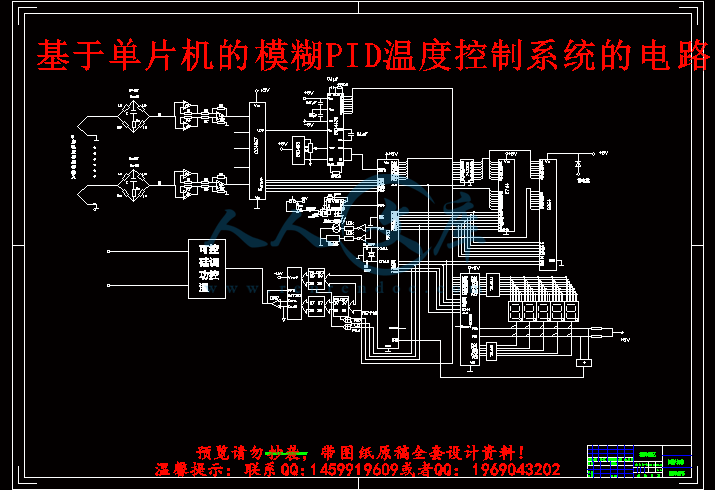基于单片机的模糊PID温度控制系统设计【优秀单片机课程毕业设计含1张CAD图纸+带任务书+开题报告+外文翻译+45页加正文21900字】
【详情如下】【需要咨询购买全套设计请加QQ1459919609】
基于单片机的模糊PID温度控制系统设计
中英文翻译.doc
任务书.doc
图纸副本.dwg
基于单片机的模糊PID温度控制系统的电路图.dwg
开题报告.doc
文献综述.doc
基于单片机的模糊PID温度控制系统设计.doc
基于单片机的模糊PID温度控制系统设计
摘 要
温度控制在热处理工艺过程中,是一个非常重要的环节。控制精度直接影响着产品质量的好坏。本文研究的电炉是一种具有纯滞后的大惯性系统,传统的加热炉控制系统大多建立在一定的模型基础上,难以保证加热工艺要求。因此本文将模糊控制算法引入传统的加热炉控制系统构成智能模糊控制系统。
本文以模糊自整定 PID 控制算法为基础,设计以8031单片机为主体的控制系统控制电炉,构成一个能进行较复杂的数据处理和复杂控制功能的智能控制器,使其既可与微机配合构成控制系统,又可作为一个独立的单片机控制系统,具有较高的灵活性和可靠性。单片机根据输入的各种命令,进行智能算法得到控制值,输出脉冲触发信号,通过过零触发电路驱动双向可控硅,从而加热电炉。
本文提出的基于模糊的自整定 PID 控制算法的控制系统具有真正的智能化和灵活性,有自动检测、数据实时采集、处理及控制结果显示等功能,对提高电炉温度的控制精度具有较好的意义。
关键词:电炉;单片机;模糊 PID。
Abstract
Temperature in heat treatment craft is very important. Control precision effect directly the quality of the product. The electric stove is a kind pure great inertia system, and the traditional heat control system is based on some certain model, so is hard to satisfy the technological requirement.This paper will adopt fuzzy control algorithm to build a intelligent fuzzy control system.
In this paper, we use fuzzy self-regulated PID algorithmt to design a electric stove control system depending on mainly 8031 chip and build a intelligent controller which can process complicated data and realize complicated control functiong, meanwhile is alao regarded as an independent SCM control system which has higher flexibility and dependability. The SCM accords to all kinds input orders to carry out intelligent algorithm in order to get control value, then to feed out the pulse signal to trigger circuit and drive the two-way silicon in order to heat the stove.
The control system based fuzzy self-regulated PID algorithm has real intelligence and flexibility. The functions include automatic detection, real-time data gather and precess and displaying the control output and so on, which do well in improving the control precision.
Keyword:Electric stove;SCM;Fuzzy PID.
目 录
第1章 绪论 1
1.1 引言 1
1.2 控制器发展现状 1
1.2.1 PID 控制器的发展现状 1
1.2.2 模糊 PID 控制 2
1.2.3 模糊自整定 PID 控制 2
1.3 电炉采用模糊自整定 PID 控制的可行性 2
第2章 模糊自整定 PID 控制器的设计 4
2.1 模糊推理机的设计 4
2.1.1 模糊推理机的结构 4
2.1.2 模糊推理机的设计 4
精确量的模糊化 5
建立模糊控制规则和模糊关系 5
输出信息的模糊决策 6
2.2 模糊自整定 PID 控制器 6
2.2.1 PID 参数对 PID 控制性能的影响 6
2.2.2 模糊自整定 PID 控制器 7
2.3 模糊自整定 PID 控制器性能的研究 8
2.3.1 Matlab 仿真结构图 8
2.3.2 惯性时间常数的影响 9
2.4 仿真结果分析 10
第3章 系统硬件和电路设计 11
3.1引言 11
3.2 系统的总体结构 11
3.3 温度检测电路 12
3.3.1 温度传感器 12
3.3.2 测量放大器的组成 12
3.3.3 热电偶冷端温度补偿方法 13
3.4 多路开关的选择 13
3.5 A/D转换器的选择及连接 14
3.6 单片机系统的扩展 15
3.6.1 系统扩展概述 15
3.6.2 常用扩展器件简介 16
3.7 存储器的扩展 17
3.7.1 程序存储器的扩展 17
只读存储器简介 17
EPROM2764简介 17
3.7.2 数据存储器的扩展 18
数据存储器概述 18
静态RAM6264简介 19
数据存储器扩展举例 19
3.8 单片机I/O口的扩展(8155扩展芯片) 20
3.8.1 8155的结构和引脚 20
3.8.2 8155的控制字的及其工作方式 21
3.8.3 8155与8031的连接 22
3.9 看门狗、报警、复位和时钟电路的设计 23
3.9.1看门狗电路的设计 23
3.9.2报警电路的设计 23
3.9.3复位电路的设计 24
3.9.4 时钟电路的设计 25
3.10 键盘与显示电路的设计 25
3.10.1 LED数码显示器的接口电路 25
3.10.2键盘接口电路 26
3.11 DAC7521数模转换接口 27
3.12 隔离放大器的设计 28
3.13 可控硅调功控温 29
3.13.1过零触发调功器的组成 29
3.13.2主要电路介绍 30
3.14 单片机开关稳压电源设计 31
第4章 系统软件设计 32
4.1 主要程序的框图 32
4.1.1主程序框图 32
4.1.2键盘中断服务子程序 33
4.1.3恒温及升温测控子程序 34
4.1.4降温测控子程序 35
4.2 模糊自整定 PID 控制算法 36
致谢 39
参考文献 40
附录 42





 川公网安备: 51019002004831号
川公网安备: 51019002004831号